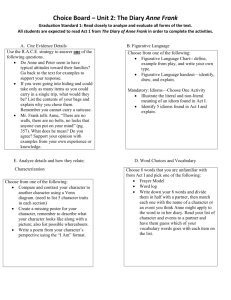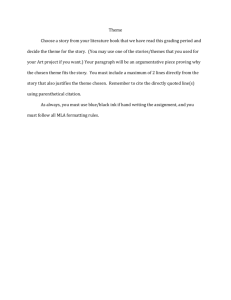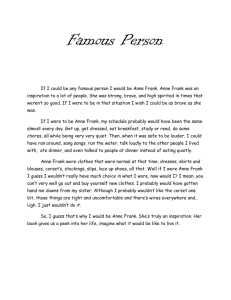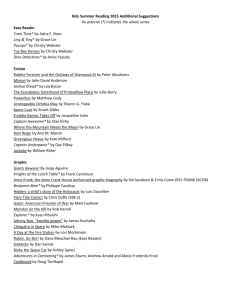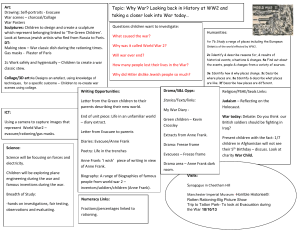Anne Frank - Nevada Adult Education Nevada Adult Education
advertisement
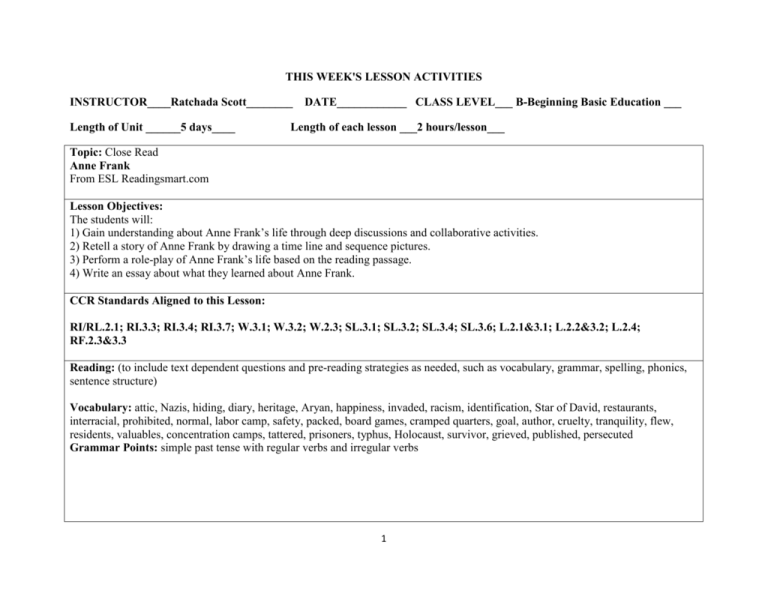
THIS WEEK'S LESSON ACTIVITIES INSTRUCTOR____Ratchada Scott________ Length of Unit ______5 days____ DATE____________ CLASS LEVEL___ B-Beginning Basic Education ___ Length of each lesson ___2 hours/lesson___ Topic: Close Read Anne Frank From ESL Readingsmart.com Lesson Objectives: The students will: 1) Gain understanding about Anne Frank’s life through deep discussions and collaborative activities. 2) Retell a story of Anne Frank by drawing a time line and sequence pictures. 3) Perform a role-play of Anne Frank’s life based on the reading passage. 4) Write an essay about what they learned about Anne Frank. CCR Standards Aligned to this Lesson: RI/RL.2.1; RI.3.3; RI.3.4; RI.3.7; W.3.1; W.3.2; W.2.3; SL.3.1; SL.3.2; SL.3.4; SL.3.6; L.2.1&3.1; L.2.2&3.2; L.2.4; RF.2.3&3.3 Reading: (to include text dependent questions and pre-reading strategies as needed, such as vocabulary, grammar, spelling, phonics, sentence structure) Vocabulary: attic, Nazis, hiding, diary, heritage, Aryan, happiness, invaded, racism, identification, Star of David, restaurants, interracial, prohibited, normal, labor camp, safety, packed, board games, cramped quarters, goal, author, cruelty, tranquility, flew, residents, valuables, concentration camps, tattered, prisoners, typhus, Holocaust, survivor, grieved, published, persecuted Grammar Points: simple past tense with regular verbs and irregular verbs 1 Text Dependent Questions Where and When was Anne Frank born? What did the German Nazis believe? Possible Student Answers Line 12; Anne Frank was born in 1929 in Frankfurt, Germany. Lines 19-21; They hated the Jews and believed that their race was the best. Lines 32-42; 1. Jews were not allowed to go to school with non-Jews. 2. There were rules for Jews that other people didn’t have to follow. 3. Jews could not appear in public without proper identification. 4. Jews were required to wear a Star of David on their clothes. 5. Jews were not allowed to go into most public places such as restaurants and theaters. 6. Jews could not own businesses. 7. Interracial dating was prohibited. 8. Jews could not be friends with non-Jews. Lines 44-46; On June 12, 1942, she had her thirteenth birthday. She received a special gift. It was a diary. She liked her diary so much that she named it Kitty. She wrote in it every day. That diary would one day tell Anne’s life story. What happened to Jews after the Nazis invaded Holland? What special gift did Anne Frank receive for her thirteenth birthday and that gift was one of the important parts of the world history? What is the cause of the Franks decided to go into hiding? Lines 48-50; Margot received a letter. The letter said she had to report to a labor camp. Margot was only sixteen. The Franks were afraid for their daughter’s safety. They decided it was time to go into hiding. Can you predict the outcome if the Franks did not go into hiding? Students may refer to lines 32-42. They would get treated unfairly and have very difficult lives because they were Jews. They all might have to go to a labor camp. Lines 77-78; On August 4, 1944, the attic door flew open. It was the Nazi police. They had received a tip that some Jews were hiding there. Lines 96-99; Two years later, Otto Frank published Anne’s diary. He wanted the world to know about his daughter. He How and when were the Franks captured? Why did Otto Frank publish Anne’s diary? 2 wanted the world to know about her life, her dreams, and her goals. It was Anne’s goal to become a famous author. She did more than this. She became a voice for Jews and for persecuted people everywhere. Summarize Anne Frank’s biography. What have you learned about Anne Frank? Students may summarize each part of her life which starts from the early life until Anne’s diary and put them together into a short essay. Writing: After students read and learn about Anne Frank, students will write what they have learned and develop a three paragraph essay. Paragraph one may include the following: Lines 11-46: Early life and The Franks go to Amsterdam Paragraph two may include the following: Lines 47-74: The Franks in Hiding Paragraph three may include the following: Lines 77-99: The Franks are captured and Anne’s diary Listening/Speaking: In groups of five people, each student will each read aloud one part of Anne Frank’s biography and discuss dependent questions Separate students into two groups, each group will choose the best summary of Anne Frank’s biography from the papers that each student wrote what they have learned about Anne Frank. Then, each group will retell and role-play Anne Frank’s story to the class. How I will scaffold my lessons to reach all of my students' levels: Teach the grammar points and practice how to them use correctly. Go through the vocabulary list and the meanings with students and give examples and pictures to help understanding. 3 Show students the maps of Germany and Holland, pictures of Anne Frank and her family, and pictures of Nazi Party, symbol, flag, and the Nazi leader, Adolf Hitler. Teach students about the Nazis and the Holocaust. (http://www.ushmm.org/wlc/en/article.php?ModuleId=10005143) (http://www.history.com/topics/world-war-ii/nazi-party) Watch a short documentary called “The Short Life of Anne Frank” (http://www.youtube.com/watch?v=i0G3mTRh9ro) Have students write Anne Frank’s timeline and draw pictures to retell her story. Show students Anne Frank’s timeline from the official site of Anne Frank. (http://www.annefrank.org/en/Subsites/Timeline/World-War-Two-1939-1945/The-German-invasion/1942/The-first-page-ofthe-diary-which-Anne-Frank-received-for-her-thirteenth-birthday-on-12-June-1942/#!/en/Subsites/Timeline/World-War-Two1939-1945/The-Hiding-place/1942/Nazi-supporters-paint-the-slogan-Holland-for-Hitler-on-the-wall-of-the-Herengracht-canalin-Amsterdam/) How I will assess my students' mastery of the lessons: Review and correct individual and group works. Observe students’ role-play from each group. Ask questions to each group to check understanding. Suggested Three Day Plan: Day One: Read the text on Anne Frank while they follow along with their copies; students, then, read the text silently and highlight words that they do not know. In small groups, students read the text out loud, taking turns and, using context clues, collaborate on the meanings of the words. Day Two: Practice reading aloud. In small groups, students discuss about the reading and answer the text dependent questions. Day Three: Each student develops a three paragraph paper about Anne Frank. This writing assignment allows time for the teacher to talk about drafts and final copies, grammar points, sentence structure points, punctuation points - all of this comes from their first draft writing. Then they share their drafts with a partner and critique each other's work. Then, they write a second draft. These can be shared in small groups for further critiquing. Then, they write their final copy. 4 Day Four: Write Anne Frank’s timeline and draw pictures to retell her story. Role-play. Divide students into five groups. Each group will role-play each part of Anne Frank’s life from early life to Anne diary. Day Five: Give students a spelling test of the vocabulary words that they didn't know in the text. Students read their final copy aloud to the whole class. They also share their timeline. Sources: 1. Murphy, Raymond. 1997. Essential Grammar In Use. 2nd edition. New York, NY: Cambridge University Press. 2. www.eslreadingsmart.com 3. http://www.ushmm.org/wlc/en/article.php?ModuleId=10005143 4. http://www.history.com/topics/world-war-ii/nazi-party 5. http://www.youtube.com/watch?v=i0G3mTRh9ro 6. http://www.annefrank.org/en/Subsites/Timeline/World-War-Two-1939-1945/The-German-invasion/1942/The-first-page of- the-diary-which-Anne-Frank-received-for-her-thirteenth-birthday-on-12-June-1942/#!/en/Subsites/Timeline/WorldWar-Two-1939-1945/The-Hiding-place/1942/Nazi-supporters-paint-the-slogan-Holland-for-Hitler-on-the-wall-of-theHerengracht-canal-in-Amsterdam/ 5 Anne Frank –On My Own Tutorial KWL Chart What I know about Anne Frank What I want to know about Anne Frank What I learned about Anne Frank 6 Anne Frank Vocabulary List 1. attic - (n.) part of a building under the roof, usually used for storage 2. Nazis - (n.) members of a German political party that wanted to get rid of Jews 3. hiding - (n.) being out of sight of others 4. diary - (n.) a book used for writing personal events and thoughts 5. heritage - (n.) family and ethnic background and traditions 6. happiness -(n.) joy 7. invaded - (v.) past of invade; attacked and took over 8. racism - (n.) treating people differently because of their race or skin color 9. identification - (n.) a paper or card that gives a person's identity or name 10. Star of David - (n.) a star with six points, originally used by King David of Israel 11. restaurant - (n.) a public place where food is bought, served, and eaten 12. interracial - (adj.) between different races of people 13. prohibited - (adj.) not allowed 14. unfairly - (adv.) not in a fair or equal way 15. normal - (adj.) regular; ordinary 16. thirteenth - (adj.) 13th 17. labor camp - (n.) a place where people are held against their will and forced to work 18. safety - (n.) a condition of being safe, out of danger 19. packed - (v.) past of pack; put into boxes or bags for storage or for moving 20. board game - (n.) game, such as Checkers or Chess, that must be played on a board 21. cramped - (adj.) very crowded and small 22. quarters - (n.) living space 23. goal - (n.) aim, ambition 24. author - (n.) writer 25. cruelty - (n.) harsh, unkind treatment 26. tranquility - (n.) peacefulness and quiet 27. flew - (v.) past of fly; moved quickly 28. tip - (n.) clue; hint; secret information 29. resident - (n.) an individual who lives in a place 30. valuable - (n.) something that is worth a lot of money 31. concentration camp -(n.) a place where Jews and others were held and later killed 32. tattered - (adj.) torn, ragged 29. prisoner - (n.) one held against his will 30. typhus - (n.) a disease or illness spread by body lice or ticks, often fatal 31. Holocaust - in the Bible, a burned offering; since World War II, it has been the word used for the Nazi murder of 6,000,000 innocent Jews and others in that war 32. survivor - (n.) a person who is still alive after an event in which others died 33. grieve -(v.) to feel sad about the death of other people 34. publish - (v.) to print for the public, for everyone to read 35. persecuted - (adj.) treated badly and unfairly 7 8


